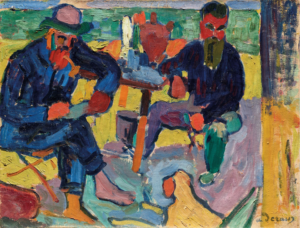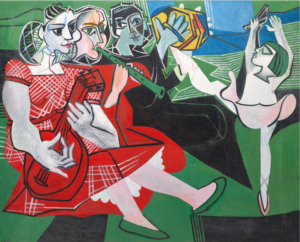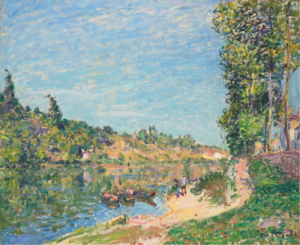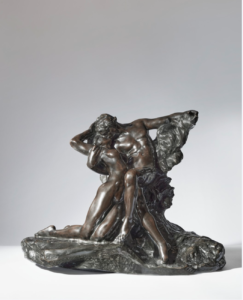On Tuesday, April 9th, Christie’s Paris hosted the first Impressionist sale that will be all the buzz the rest of the week. They started with their “oeuvres choisies,” or select works, a collection of twenty-three paintings and sculptures from prominent nineteenth and twentieth-century European modernists like Sisley, Matisse, and Chagall. Unfortunately, no one could watch the sale online thanks to a technical malfunction with Christie’s Live, which the support staff seemed unable to fix for the entire forty-five-minute duration of the auction. I could record the results and calculate the hammer prices, but it didn’t really have the same excitement it normally would have. With these sorts of sales, a prominent Impressionist like Renoir usually claims the top. However, the Tuesday sale took a surprising turn. This time, it was Fauvism that stole the spotlight with André Derain’s painting Matisse et Terrus. Christie’s specialists seemed to understand the value of the work since it was the only lot valued at over €1 million. The painting was created when the three artists spent time with each other in the summer of 1905, at the height of the Fauvist movement. Matisse, along with Derain, was one of the leading Fauvist painters. Terrus, meanwhile, was mainly known as a landscape painter from the far south of France, near the border with Spain. Some may be more familiar with Terrus as the namesake of the Musée Terrus, which came into the news in 2018 after a visiting art historian concluded that over half of the museum’s contents may be fakes. Derain gifted the work to Terrus, whose descendants kept it in close to perfect condition for over a century. In terms of fauvist art, Derain’s paintings are definitely more rare compared to other artists like Matisse. The roughly 16-by-21.5 inch oil on canvas painting was predicted to sell for between €2 million and €3 million, with the hammer coming down at €2.6 million / $2.8 million (€3.19 million / $3.47 million w/p).
Immediately after the Derain came the second place lot, though few people would’ve guessed it. Christie’s specialists seemed to think that one of the Sisley paintings or perhaps the lone Pissarro might make it to the top three. However, it ended up being one of the sale’s two women who took second place. Françoise Gilot’s oil on panel painting Le Concert Champêtre, or Concert on the Green, is a rather large work, measuring 51 ¼ by 63 ¾ inches. Gilot created it in early 1953, during the final months of her decade-long romantic relationship with Pablo Picasso. The painting from Tuesday’s sale displays hints of Picasso’s style while remaining unique. Picasso experts say that the Spanish master assigned a different color to each of the important women in his life, with Gilot’s color being green. Christie’s assigned the Gilot an estimate range of €200K to €300K, with the hammer coming down at €1.05 million / $1.14 million (or €1.3 million / $1.43 million w/p). As I wrote several weeks ago, the Picasso Museum in Paris curated one of its gallery spaces dedicated to Françoise Gilot’s work, which commentators say is a significant step towards Gilot’s rehabilitation in France, where her reputation suffered immensely after her break with Picasso. In North America and, to some extent, the rest of Europe, Gilot’s popularity and reputation have remained mostly intact, with her work selling for far greater amounts at auction houses in London and New York. Le Concert Champêtre is now Gilot’s fourth most valuable painting and is by far the most valuable of her paintings ever sold in France. Not only is this one of the artist’s biggest moments at the auction block, but it may serve as a bellwether testifying to Gilot’s reputational rehabilitation in France.
Two lots were tied for third place, each selling for €550K / $598.3K (or €693K / $753.8K w/p). The first was one of the two Sisley paintings featured during the sale. Sisley painted Les Coteaux de La Celle, après Saint-Mammès in 1884, not long after moving to the Moret-sur-Loing area in the countryside just south of Paris. Like much of his work, Sisley focuses on the Seine, capturing its banks at Vernou-la-Celle-sur-Seine, just a few miles east of Fontainebleau. With a range of €400K to €600K, the Sisley fell nicely within its estimate. Meanwhile, the other lot sharing third was the single work by Rodin in the sale. Rodin originally exhibited the original marble sculpture Éternel printemps, or Eternal Springtime, at the Salon in 1897. After that, he created multiple versions cast in bronze, including this one, which he cast during his final years between 1916 and 1917. The sculpture has intrigued many, leading some to guess that the figures represent Cupid and Psyche, or perhaps they are personifications of the wind and the earth. It slightly exceeded the €300K to €500K estimate Christie’s assigned it.
The sale did incredibly well, with eleven of the twenty-three available lots selling within their estimates, giving Christie’s specialists a 48% accuracy rate. An additional three lots (13%) sold below, while eight lots (35%) sold above. Only one lot, an oil on canvas painting by Le Corbusier, went unsold, giving the sale a 96% sell-through rate. In total, the sale made €9.9 million, well within its presale estimate range of €7.39 million and €11.37 million. It’s important to remember that a quarter of the sale’s total came from the Derain painting.




